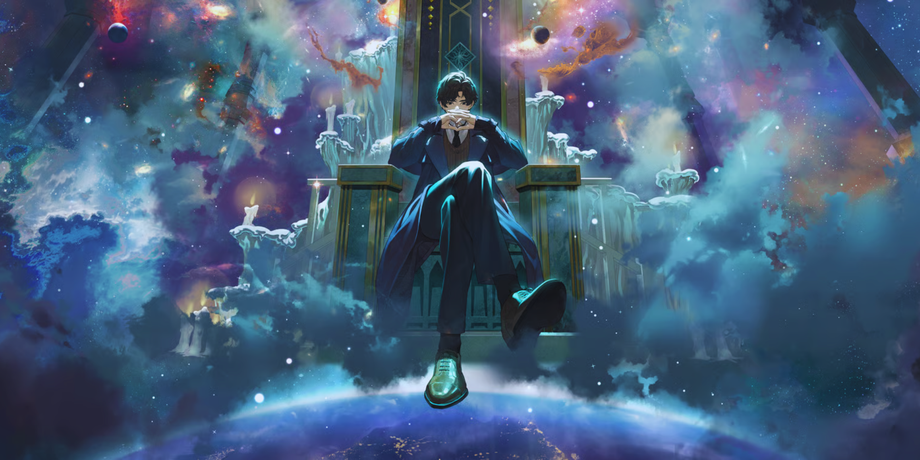A new contender at the top of anime
For decades, Japan defined the global standard for animated storytelling with giants like One Piece, Dragon Ball, and Naruto. In 2025, a Chinese series arrived with the kind of scope, polish, and conversation-driving power that usually surrounds top Japanese releases. Lord of Mysteries, adapted from a hit Chinese web novel, has pushed Chinese animation into the same spotlight. It pairs cinematic craft with a dense, addictive mystery that has viewers comparing notes every week. The result is a project that feels like a turning point, not only for one studio, but for how global audiences talk about anime and donghua.
- A new contender at the top of anime
- The story and the world
- Production values that rival the best
- Rewriting isekai and dark fantasy conventions
- How viewers are responding
- A finale that thrilled China and frustrated overseas fans
- A rising tide for donghua
- Distribution and translation are the real battleground
- What comes next for Lord of Mysteries
- Key Points
Powered by painterly visuals, near feature film shot design, and a Victorian setting infused with steampunk and cosmic horror, the show debuted to surging interest. A two episode premiere introduced viewers to a layered world of secret societies and occult science, then kept the pace with nearly 30,000 frames per episode. That level of detail gives the action and atmosphere a tactile presence. Early reactions positioned Lord of Mysteries alongside the most talked about fantasy series of the year. It is not only a breakout for B.CMay Pictures, it is a signal that Chinese studios now aim for the very top of the global conversation.
The story and the world
Lord of Mysteries begins with Zhou Mingrui waking up in the body of Klein Moretti, a university graduate in a city that looks and feels like an industrial age London. That city, Tingen, hides a web of governments, churches, and secret orders that traffic in mystical rites. Power in this world comes from understanding forbidden knowledge, completing rituals, and drinking carefully prepared potions that place a person on a path of transformation. Those who gain abilities this way are known as Beyonders.
Klein inherits a life he does not understand, then discovers that even the method that brought him here might be repeated. He experiments with a ritual that elevates him above the fog of reality, adopts a godlike persona to conceal his identity, and creates the Tarot Club, a clandestine circle where masked figures trade information under codenames. The power system is intricate. Beyonder potions are grouped into Pathways like Seer, Clown, Sleepless, and Scholar, each with unique abilities and psychological risks. Advancement grants new skills, but it chips away at sanity and identity. That tradeoff gives the series its constant tension. Every gain carries a cost, and every revelation opens a deeper layer of danger.
Production values that rival the best
The visual presentation is where Lord of Mysteries announces its ambition. B.CMay Pictures blends richly painted 2D character work with carefully integrated 3D environments, then lights scenes like a period thriller. Flickering gas lamps throw long shadows across wet cobblestones. Interior scenes glow with candlelight and muted colors. Camera movement often feels cinematic rather than televisual, with slow pushes, carefully framed inserts, and perspective shifts that emphasize the scale of the city and the weight on Klein’s shoulders.
The studio reportedly targeted nearly 30,000 frames per episode, a volume that shows up in the fluidity of motion and in the number of small gestures the characters make during dialogue. Early installments even skipped typical opening and ending sequences to keep immersion intact. Music and sound work hard too, layering choral and string motifs over investigative scenes, then hitting hard during confrontations. The season finale highlighted the production’s confidence by animating a giant, grotesque enemy entirely in 2D, avoiding the shortcut of computer generated creatures and delivering a fight that felt heavy and physical.
Rewriting isekai and dark fantasy conventions
Labeling Lord of Mysteries as simple isekai undersells what it tries to do. The premise of a main character from modern China waking up in another body remains, but the tone is closer to occult detective fiction. It trades the familiar power grind of many action shows for a methodical dance of investigation, bargaining, and carefully prepared rituals. The plot trusts viewers to follow the rules of a complex world while it unspools secrets slowly, then punctuates the quiet with shocking, often tragic turns. This is a series that wants you to feel the city breathing around the characters, then recoil when something alien slips through.
A power system with consequences
Beyonder potions do not hand out simple upgrades. Each Pathway shapes a person’s mind and body, and the farther someone goes, the more the Pathway asserts itself. The Seer line sharpens intuition and divination but tempts paranoia and distorted perception. The Clown line grants agility and misdirection but teases loss of control. Advancement requires rare ingredients and often forces characters into dangerous dealings. That structure keeps stakes high. A misjudged step does not just risk defeat in a fight. It risks permanent loss of self.
Atmosphere first, spectacle second
When action arrives, it hits harder because the series spends so much time building unease. Street corners feel watched. Library stacks whisper. Church bells carry hints of unseen hands at work. Lord of Mysteries favors atmosphere over constant set piece combat, which differentiates it from contemporaries built on relentless battles. Viewers drawn to Solo Leveling’s steady rise of power will find a different flavor here, where success depends on reading a room, leveraging information, and knowing when not to trigger a ritual at all.
How viewers are responding
Early episodes earned strong scores on prominent rating sites and created immediate word of mouth outside China. Reviewers praised the cinematic look, the way the soundtrack lifts key scenes, and the balance of humor and tension during Tarot Club meetings. An episode built around a fishing trip with Azik that pivots into a heartbreaking confrontation showed how the show can flip tones without losing coherence. The creative team often leaves breadcrumbs for attentive viewers, then pays them off in emotionally heavy sequences that linger.
That said, the adaptation makes aggressive choices. The director and author have both acknowledged rearranging plot points to fit a dense novel into a limited season. Some viewers felt the first weeks moved fast, with inner monologues and fine details compressed or left implied. Subtitles on early international streams drew criticism for occasional errors or omissions, and some worldbuilding texts seen on screen were not translated in the initial release, which confused new audiences catching essential lore through visual cues.
Feedback from long time readers and new fans captures both admiration and frustration. One common theme is that the show sometimes races to highlight set pieces rather than letting quiet moments breathe. As one fan in the Lord of the Mysteries subreddit put it after watching the first run of episodes:
Very fast pacing and vague explanations of many things to get to the action scenes quickly.
Simultaneously, the crowd that prefers a denser narrative has embraced the challenge. The Tarot Club’s banter has been a weekly favorite, with Klein’s careful bluffing playing off a cast that includes a sharp noblewoman and a wary sailor. The combination of humor, secret history, and real consequences is what keeps conversations lively between episodes.
A finale that thrilled China and frustrated overseas fans
As the season closed, the production team organized a theatrical event for the last chapters in China. The finale also appeared early on a domestic platform, which left many overseas viewers waiting while spoilers spread across social feeds. That decision ignited debate. On one hand, Chinese fans enjoyed a communal screening designed to celebrate the show’s success. On the other, the choice cut out a large international audience that had discovered the series through legal streaming and had been championing it for months. It was a reminder that even a breakout hit can be tripped up by regional release strategies.
When fans did see the ending, the conversation shifted back to the story itself. The Nighthawks confronted a monstrous threat named Megose in a sequence that many called the animation peak of the season. Dunn’s sacrifice landed with weight, paying off subtle foreshadowing. A shocking twist removed Klein from the board before the gray fog’s power intervened, setting up a new status quo that promises a broader confrontation in the next chapter. The finale balanced tragedy with a small moment of grace when Klein visited his siblings in disguise, a choice that underlined the show’s commitment to character even as the plot scales up.
A rising tide for donghua
Lord of Mysteries did not appear in a vacuum. The last several years have seen Chinese series like The King’s Avatar, Grandmaster of Demonic Cultivation, and Link Click draw international attention. Early 2025 brought To Be Hero X, an anthology concept that expanded the audience for Chinese animation with a different style and sense of humor. That momentum reflects broader changes. Studios that once focused on outsourcing work have built original pipelines. Budgets have grown. Directors have embraced a blend of 2D and 3D that suits stories set in modern cities and historical environments. Each success makes it easier for the next project to find viewers.
There are still hurdles. Japan produces a massive volume of titles every year, including many with world class craft. Chinese studios cannot match that quantity, and many projects still aim first at domestic viewers, with international distribution arriving later. Even so, the mix of creative risk and craftsmanship in recent donghua suggests a wider space for non Japanese animation on the global stage. The point is not replacement. It is variety. Fans win when there are more approaches to fantasy, science fiction, and drama executed at a high level.
Distribution and translation are the real battleground
How Lord of Mysteries reaches viewers is almost as important as how it looks. The show launched on major streaming platforms with wide reach, and that decision helped it cross borders quickly. At the same time, early subtitling issues slowed momentum among newcomers who needed precise translations of ritual terms and in world languages like Hermitspeak and Ancient Hermes. Moments where on screen text was not translated left gaps in understanding for people who had not read the novel.
Dubbing options are expanding, which will make it easier for wider groups to give the series a try. A multilanguage release strategy also demands careful coordination with local platforms to avoid spoilers and confusion. The finale misstep was a case study in how easy it is to dampen international enthusiasm. Creators and distributors who treat global fans as part of the primary audience from the outset will build more durable franchises.
What comes next for Lord of Mysteries
The creative team has already signaled that season 2 is underway. The first season covered the opening stretch of the novel and established rules that can support many arcs. Plans for multiple seasons and special installments are in motion, and a feature length project has been discussed. Beyond television, a role playing game (RPG) based on the property has been in development on Unreal Engine 5, which hints at longer term transmedia ambitions. If the show continues at its current quality, and if release logistics improve, it could sustain conversation for years.
For viewers deciding whether to start, the case is straightforward. If you like intricate rules, secret societies, and a protagonist who wins as often with planning as with power, the show delivers. If you prefer action every minute, expect a patient build punctuated by crisp, heavy fights. The best way to watch is with attention to detail. The most rewarding payoffs come from remembering small names, symbols, and rules introduced early, which later become the keys to survival.
Key Points
- Lord of Mysteries is a 2025 Chinese animated adaptation of a hit web novel set in a Victorian style world of occult science and secret orders.
- The production blends painterly 2D with integrated 3D and targets nearly 30,000 frames per episode for fluid, cinematic visuals.
- The power system centers on Beyonder potions and Pathways like Seer and Clown, with real psychological risks attached to advancement.
- Early reaction praised the look, soundtrack, and Tarot Club dynamics, while criticism focused on fast pacing and subtitling issues.
- A domestic theatrical finale and early platform release in China created spoiler problems for overseas fans waiting on international streams.
- The season finale delivered major character deaths and a shocking twist before setting up a wider conflict for season 2.
- Chinese animation has been rising with titles like Link Click and To Be Hero X, and Lord of Mysteries has become its flagship for 2025.
- Distribution, translation accuracy, and timely global access remain the main challenges to fully capitalizing on the show’s momentum.
- Season 2 is in development, with long range plans discussed across multiple seasons and a possible feature, plus an RPG project in the works.




